The AMD Ryzen 9 7950X3D Review: AMD's Fastest Gaming Processor
by Gavin Bonshor on February 27, 2023 9:00 AM ESTConclusion
When AMD unveiled its Ryzen 7 5800X3D with 96 MB of L3 cache, which was made possible with AMD's 3D V-Cache chiplet packaging technology, it changed the game figuratively and literally. In games that can leverage that massive pool of L3 cache to their benefit, the 5800X3D looked like a superstar, but the only thing letting it down was the compute performance on offer. In those situations, it was worse than the existing Ryzen 7 5800X and cost $100 more. It was marketed and targeted at gamers and worked well, but that part was really only the first taste of what was to come – it was only a matter of time before AMD rolled out new X3D SKUs with the better-performing Zen 4 cores.
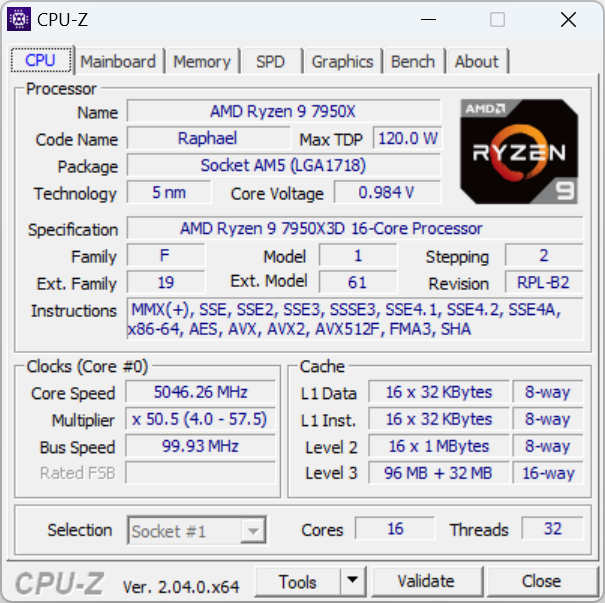
AMD Ryzen 9 7950X3D CPU-Z screenshot
Bringing their V-Cache technology forward to the latest generation of CPUs, AMD has much bigger plans this time around. Rather than only releasing a single part based on a mid-range chip design, AMD has put together a three chip stack that encompasses their flagship CPU configurations for the first time. The combination of AMD's now well-proven Zen 4 CPU architecture and additional L3 cache makes for a potent partnership compared to AMD's previous generational offering, with faster CPU cores and a new scheduling mechanisms to help Windows allocate threads on what is increasingly a non-homogenous CPU architecture.
AMD's decision to build an asymmetrical CPU design makes for some interesting fodder for analysis. Parking CPU cores and altering core priorities on the fly adds a new layer to the onion that is OS thread scheduling, but it's a necessary layer all the same for AMD to make the jack-of-all-trades type of chip that they set out to build. A homogenous chip using two V-Cache equipped CCDs would have been easier to work with, but it would have taken a bigger hit in compute performance, and likely more critically, it would have been even more expensive at time when consumers are already bristling at PC hardware costs.
In any case, with the flexibility of pretty fast cores for compute performance, and an 8-core CCD with 96 MB of L3 V-Cache that soaks up games, the Ryzen 9 7950X3D is a 16-core powerhouse that looks to provide gamers with more performance without asking them to give up too much compute performance in the process.
AMD Ryzen 9 7950X3D Analysis:
We saw different performance levels throughout as we put the Ryzen 9 7950X3D through its paces in our CPU suite. The AMD Ryzen 9 7950X3D will be hitting the streets tomorrow at $699, while the latter is currently available at the time of writing from Amazon for $589. This means the 7950X3D will be carrying a $110 premium over what has been AMD's flagship chip for compute and gaming over the past 5 months.
For this review, we've analyzed the compute and gaming performance separately.
AMD Ryzen 9 7950X3D Gaming Analysis: 3D V-Cache Wins Again in Gaming, But Not in All Titles
When we reviewed the AMD Ryzen 5800X3D, we observed that some titles benefitted from the 3D V-Cache more than others; some of the titles in our suite weren't impacted. And with the Ryzen 7000 family, that hasn't changed – the benefits of the additional 64MB of L3 cache vary from title to title.
A quick summary of gaming performance highlights that games that can benefit from the 3D V-Cache perform very well. Some cases, such as Hitman 3, perform exceptionally better than the competition.
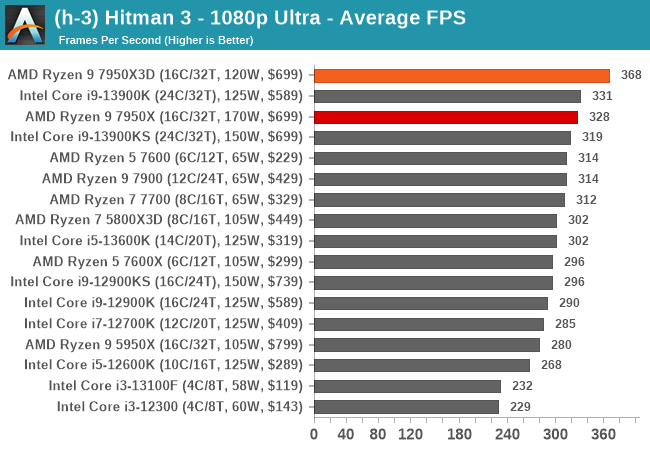
Looking at performance in Hitman 3 at 1080p Ultra settings, we can see that the Ryzen 9 7950X3D outperforms the Ryzen 9 7950X by around 12% in average frame rates. This is quite a jump in performance from just the L3 cache, and it plays into the hands of AMD here. While not all games on the market are optimized for processors with large cores, we can see that the Ryzen 9 7950X3D, when gaming, operates as an 8-core chip with 96 MB of L3 cache, outperforming the Ryzen 9 7950X with 16-cores and faster ones at that.
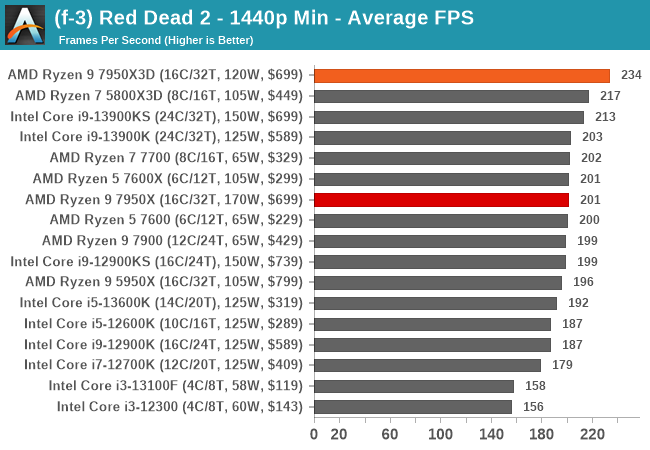
Another title where the 3D V-Cache boosts performance is Red Dead Redemption 2, one of the most popular open-world games. At 1440p minimum settings, we saw an increase of around 16% in average frame rates compared to the 7950X, which is very impressive. Concerning the Ryzen 7 5800X3D, which also showed solid performance levels, the Ryzen 9 7950X3D beat it by nearly 8%.
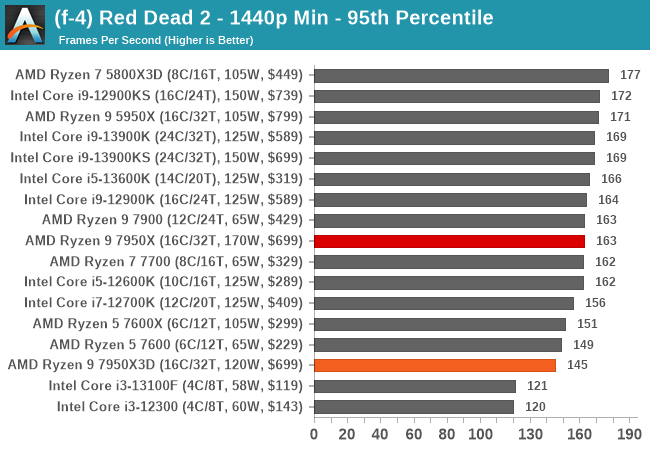
Perhaps the only caveat to the Ryzen 9 7950X3D in gaming came at the 95th percentile, which looks at the slowest 5% of frames. Where minimum frame rates and 5% lows are essential, the Ryzen 9 7950X3D saw 11% lower 95th percentile frame rates when compared to the 7950X. Taking our results in Red Dead Redemption 2 at 1440p as a prime example, we saw average frame rate gains over the 7950X by around 16%, but performance regressed by 12% at the 95th percentile.
Our suspicion here is that we're seeing the lower clockspeeds of the V-Cache CCD rear its head. Bottlenecks shift during the frame generation process (AI, physics, world generation, etc), so where RDR2 benefits from the extra cache in some points, it may now be more compute bottlenecked in others. We did see examples with the Ryzen 7 5800X3D also displaying solid levels of average frame rate performance in some titles, but it was somewhat let down by 95th percentiles in some. The Ryzen 9 7950X3D is more consistent in 5% low performance, and although it wasn't in every instance or every title, we did observe this in Red Dead Redemption 2 and World of Tanks. Like virtually everything else about the additional L3 cache, it's all very situational.
Overall, the gaming performance on display from AMD's Ryzen 9 7950X3D is undoubtedly impressive, and in titles where the 3D V-Cache can be leveraged, the 7950X3D is excellent. As you'd likely expect from hardware changes that improve the CPU, the biggest wins came at 1080p and 1440p resolutions, where the GPU is less likely to the bottleneck. And while 4K performance was still respectable, games are definitely more likely to be hard bound by GPU performance there. Much like the older Ryzen 7 5800X3D, the Ryzen 9 7950X3D is a chip primarily marketed for gamers, and from our testing, it's undoubtedly a smart move from AMD.
As an aside, given just how situational the performance benefits are of AMD's V-Cache, it would be nice to see AMD put together some sort of performance guide, even if it's only on a semi-official basis. Having a list of games that see a performance benefit (and by how much) would be very helpful for buyers trying to decide on whether to splurge on the X3D chip, I believe. This is data AMD should already have in-house, especially as the GPU side of the business is already doing regular automated performance testing for new drivers.
AMD Ryzen 9 7950X3D Compute Analysis: Slightly Slower than the 7950X
Although the AMD Ryzen 9 7950X3D makes for a potent improvement in gaming workloads, there are far fewer examples of general computing workloads where the large amounts of L3 cache outweigh higher CPU frequencies. While AMD has narrowed the gap versus what we saw with last year's single-CCD 5800X3D, the crux of the matter is the Ryzen 9 7950X3D still ends up being slower than the Ryzen 9 7950X in most computing tasks. While AMD's drivers, optimizations, and CCX switching in games work well, for anything that can fire up more than 16 threads – enough work to spill over in to both CCDs – the clockspeed penalties from the V-Cache CCD and overall lower TDP inflict a price.
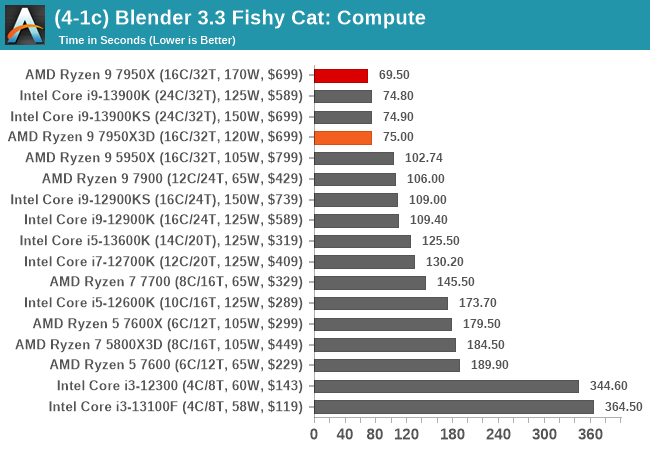
Taking examples from our CPU suite as a prime example that the Ryzen 9 7950X3D is slightly slower than the Ryzen 9 7950X in compute, we can see in the Blender 3.3 Fishy Cat (rendering) test that the Ryzen 9 7950X3D is around 7% slower than the Ryzen 9 7950X. This test put the Ryzen 9 7950X3D below the Intel Core i9-13900KS and 13900K, whereas the Zen 4 16 core goliath, the 7950X, does best. The Ryzen 9 7950X is a rendering beast, and although the Ryzen 9 7950X3D still performs well, the proof is in the pudding that users not too fussed about gaming are likely better off sticking with the architecturally homogenous (and very highly clocked) 7950X.
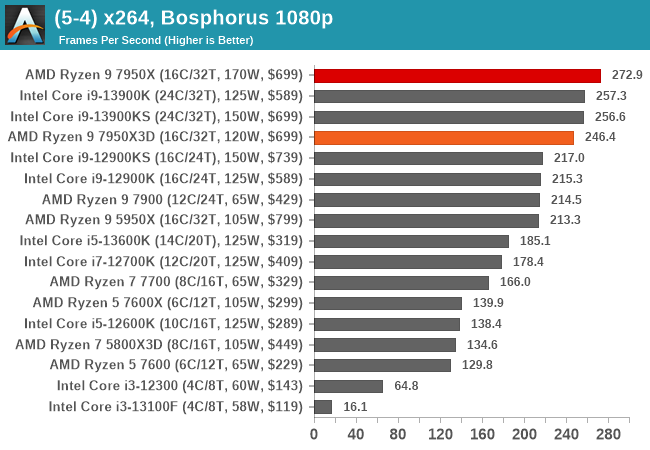
In encoding performance, and using our results in the x264 Bosphorus 1080p benchmark, we see much of the same again between the Ryzen 9 7950X3D and 7950X directly, as well as the positioning of the performance including the flagship 13th Gen Core i9-13900KS and 13900K processors. The Ryzen 9 7950X3D was a bit less than 10% slower than the Ryzen 9 7950X in this particular test, while it was only 4% slower than the Core i9-13900KS. I would still consider this a win for AMD, to an extent, as both chips will retail for similar prices, while the Ryzen 9 7950X3D offers more scope in gaming performance due to the inclusion of the 3D V-Cache.
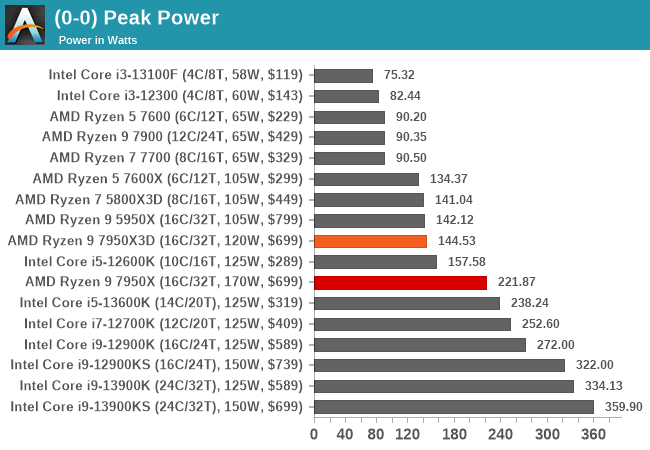
Ultimately, the Ryzen 9 7950X3D still performs respectably in rendering, encoding, and other intensive workloads, but it's clear that the Ryzen 9 7950X still holds the performance crown here for AMD. Given that the Ryzen 9 7950X3D at full load uses around 35% less power than the 7950X, this would always impact performance. Despite this, the Ryzen 9 7950X3D still performed well in our compute section, showing that Zen 4's performance per watt efficiency is excellent. If anything, the 7950X is the outlier in this respect, as these results again underscore how AMD had to sacrifice a lot of that efficiency in the name of attaining all-out performance for their fastest parts.
AMD PPM Provisioning & 3D V-Cache Performance Optimizer Aren't Always Right
Focusing on AMD's new PPM Provisioning and 3D V-Cache Performance Optimizer drivers, we did come across an example where putting all the workload on both CCDs yielded the wrong outcome for performance. Technically an edge-case scenario, we found that AMD's drivers and Microsoft's Xbox Game Bar failed to properly detect that the headless benchmark version of Factorio was running.
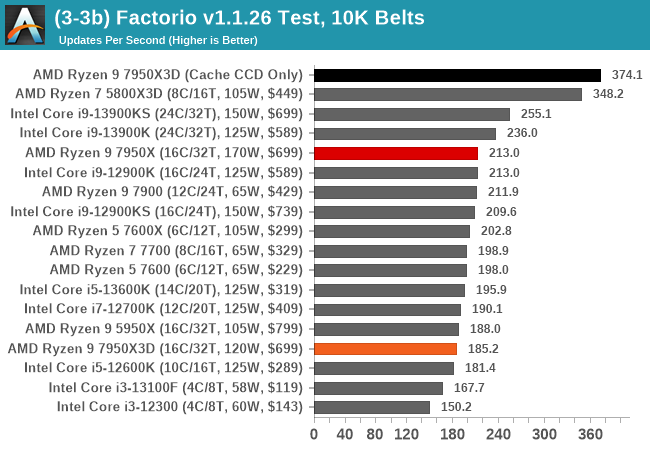
As we can see in our Factorio benchmark, we saw massive gains of over 100% when forcing the Ryzen 9 7950X3D to use the CCD with the 3D V-Cache, as opposed to letting AMD's PPM Provisioning and 3D V-Cache Optimizer drivers do their things automatically. Otherwise, when left to their own devices, X3D software stack – and specifically, the Xbox Game Bar – weren't able to recognize our Factorio benchmark run as a game that warranted intervention.
Factorio aside, we saw the AMD PPM and 3D V-Cache Performance Optimizer drivers working very well throughout our testing. So, while there's clear room for improvement, AMD's first foray into heterogeneous CPU cores is on the right track.
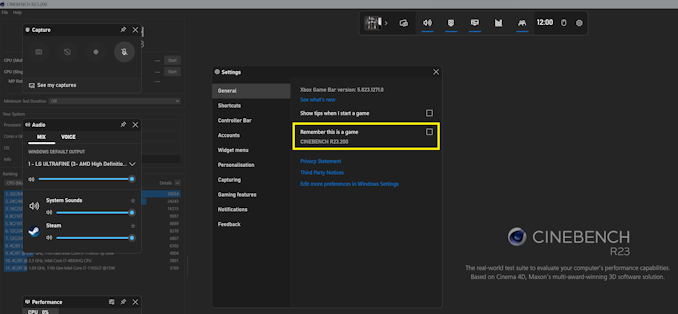
Users can force the Ryzen 9 7950X3D to use the 3D V-Cache in Xbox Game Bar.
For users who want to force the system to use the CCD with the 3D V-Cache, it can be enabled in the AMD Ryzen Master software, as well as within the firmware. Users can also circumvent the software by opening software or a game unfamiliar to the Xbox Game Bar and ticking the check box to tell the Game Bar that the active application is in fact a game. At the end of the day, AMD has firmly attached their buggy to Windows' Game Mode here, so how well Windows identifies games is going to dictate whether a program gets sent to the right CCD.
Final Thoughts: The Ryzen 9 7950X3D is For Gamers, But It's Still Respectable in Compute
AMD's Ryzen 9 7950X3D is targeted more at gamers than content creators. What's interesting about the new Ryzen 9 7950X3D when directly compared to the Ryzen 7 5800X3D is that the 7950X3D further enhances AMD's 3D V-Cache chiplet packaging. The Ryzen 9 7950X3D benefits from 128 MB of 3D V-Cache (96 MB on one CCD) and has the latest Zen 4 cores based on TSMC's 5 nm node, which has an IPC and frequency advantage over Zen 3.
Where the similarities end between the Ryzen 9 7950X3D and the Ryzen 7 5800X3D, the Ryzen 9 7950X3D does gaming excellently in titles that can leverage the 3D V-Cache, but it also has plenty of grunt from the 16-cores in compute tasks. Although we saw just one X3D SKU from AMD's Ryzen 5000 generation, AMD is releasing three for Ryzen 7000.
The most expensive and perhaps best of these Ryzen 7000X3D SKUs is the Ryzen 9 7950X3D, which has an MSRP of $699, and although we haven't reviewed the Ryzen 9 7900X3D, and the Ryzen 7 7800X3D doesn't launch until April, the Ryzen 9 7950X3D should fare better than the others in compute performance. Regarding gaming performance, it's hard to judge if the Ryzen 9 7950X3D will outperform the Ryzen 7 7800X3D when it launches.
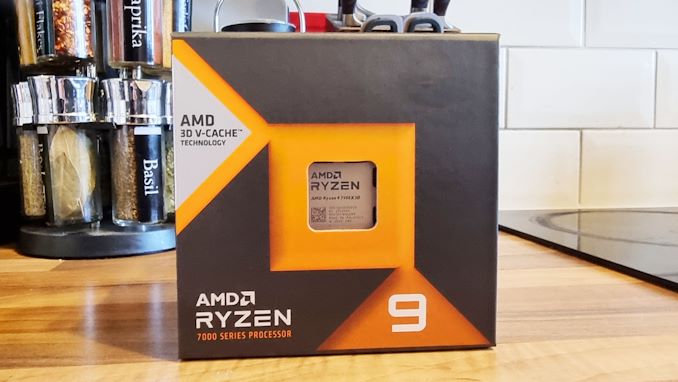
AMD has cooked up an absolute gaming powerhouse with the Ryzen 9 7950X3D
This is because the Ryzen 7800X3D is an 8-core/16-thread part with 96 MB of 3D V-Cache on one CCD, while the Ryzen 9 7950X3D operates as an 8-core/16-thread part with 96 MB of 3D V-Cache when in 'gaming mode. So, taking the above into account when factoring in gaming performance for the price, the Ryzen 9 7950X3D has an MSRP of $699, while AMD intends to launch the Ryzen 7 7800X3D for $449 on the 6th of April. Both of these chips should have similar levels of performance in many games, providing a quandary for users and gamers alike to decide.
For users looking for a solid all-around chip that can deliver leading gaming performance but still hang with the top dogs from Intel and AMD in compute performance, the Ryzen 9 7950X3D is an excellent offering. Even at $699, it represents a leading-edge offering with the latest Zen 4 cores packaged with AMD's 3D V-Cache. It benefits gaming performance in specific use cases where the game can leverage a large level of L3 cache.
If you're looking for the highest levels of compute performance for tasks such as video rendering and content creation, and it has to be Ryzen 7000, then the Ryzen 9 7950X still holds the overall performance crown. AMD has done a superb job with the Ryzen 9 7950X3D making it the fastest gaming processor in titles that can use the 3D V-Cache, while still offering decent performance in compute; that's a win for AMD. AMD's PPM Provisioning and 3D V-Cache Performance Optimizer drivers both work well and bolster the overall efficacy of the processor to deliver the right workload to the suitable CCD.
The Ryzen 9 7950X3D is still respectable, but if gaming isn't your thing, then the Ryzen 9 7950X is currently cheaper than the 7950X3D at $589 from Amazon and still offers a good balance between gaming and compute performance. Otherwise, if gaming is your thing and you're well informed that the titles you play the most can benefit from the 3D V-Cache, then the Ryzen 9 7950X3D is the way to go.
It could be worth waiting for the Ryzen 7 7800X3D if gaming is the only thing you do, as it's around 55% cheaper (at MSRP) than the Ryzen 9 7950X3D and should, in theory, offer the same levels of gaming performance. It should also be noted that the Ryzen 7 5800X3D is currently on offer from Amazon for $323, representing excellent value for gamers.










122 Comments
View All Comments
Kuhar - Tuesday, February 28, 2023 - link
@Dizoja86 nice comment :) I was waiting for one like it!mikato - Tuesday, February 28, 2023 - link
LOL, fully agree. Is that for real?Gastec - Wednesday, March 1, 2023 - link
If they would give us the very best of their tech at an acceptable price then the consumers would not upgrade every X short interval of time, they would not consume as much as desired, and profits would dwindle. The spice must flow.escksu - Wednesday, March 1, 2023 - link
I don't see that and intentionally cripple the 7950x3d.And has to balance out price Vs market demand and finishing returns. For end users, the main benefit from the extra cache is mostly just gaming. Dumping more cache doesn't necessarily means games will run faster.. then we have to look at thermals as well.
Also, even though you are willing to pay $1000, it doesn't mean everyone will. AMD doesn't make decisions based on what a few individuals want.
Samus - Tuesday, February 28, 2023 - link
No matter how you look at this, improperly optimized or not, it's impressive AMD pulled this off with reliable performance gains. The optimizations are all in software\drivers at this point, which is strange to say for a CPU that hasn't had any 'architectural' modification unless one were to consider L3 cache part of the 'architecture.'But I think we all agree this is going to be nuts when they stack V-Cache on both CCD's, presumably using a cheaper manufacturing process to possible keep costs identical or lower.
The trick now is going to be getting devs to optimize for large L3 caches. That shouldn't be hard due to AMD's presence in the console market, possibly pitching this as a next-gen console design win, but at the same time they have a fraction of the marketshare Intel has and traditionally devs have slept with Intel while AMD is on the sofa.
Blueskull - Thursday, March 23, 2023 - link
AMD knows exactly how to add X3D to all CCDs, just like the existing 7773X and the upcoming 9004X series. The problem is, however, that those server chips are NOT designed for gaming, and don't have crazy high clock rates. For gaming, you need high clock on at least some cores, and adding X3D severely limits clock speed. This is the balance they try to strike.The 50W less TDP penalty is what you pay for adding X3D to one CCD, and if you add X3D to both, you will have to pay 100W of TDP penalty. This makes the total power budget a mere 70W, and this is probably not good for single core speed.
Though 35W/CCD is kinda low, but if you put 12 of those, it still has a total TDP in north of 400W, what's how Genoa-X gets its performance. On a desktop platform for gaming? This could be really bad.
That being said, 35W-rated laptop Ryzens can still sustain 3.xGHz, so that is not low by any standard. Heck, my laptop runs at less than 2.5GHz sustained, and I never had a problem running any productivity tools, though clearly I do not game. This lower clock impacts server applications by very little, so the "all X3D" method works for this market.
Getting higher TDP while having X3D is kinda difficult, and I don't think they are getting there any soon. The problem is the thickness of that extra stacked chip, and that thickness translated to thermal resistance. Moreover, the thermal gradient on the X3D chip causes it to expand more near the CCD and less near the IHS, giving it a trapezoidal deformation. This applies tremendous amount of stress on the hard material (in the level of hundreds of MPa to a few GPa), causing both the CCD and X3D to fail prematurely.
So, mother nature doesn't seem to like the concept of X3D when single core performance is important, and AMD must figure out a way to solve this.
DanNeely - Monday, February 27, 2023 - link
Buying a mid-range CPU and putting the savings into the GPU has been the most short term bang for the buck in a gaming system for years. The main risk if you're someone who keeps the base system and swaps in faster GPUs every other year or so is that the mid-range CPU might not age well.A fairly recent example is that while fine at the time, intel's 4 core 4 thread i5 processors ended up becoming CPU bottlenecks several years before the 4/8 core i7s from their generation did.
CaptRiker - Tuesday, February 28, 2023 - link
still running a system from 2015intel hedt 5960x (8c/16t) oc'd to 4ghz
32gig pc-2166 memory
asus rampage V extreme X99 mobo
thermalake 1200watt ps
all 7 yrs old.. was running dual 980 ti's in sli when I put it together
then switched out to a 2080 ti 4 years ago.. then last month 2080 ti died so now
I'm sporting a brand new gigabyte aero oc 4080
running pretty well atm (win 10 pro w/all latest patches and feature updates)
I did recently mothball my original Intel 750 1.2tb nvme ssd card (was very close to max endurance). put in a 2tb Kingston fury nvme ssd (running in 3.0 mode since mobo only has single 3.0 m.2 slot)
Gastec - Wednesday, March 22, 2023 - link
And why do we need to know all that? That you've bough expensive video cards, that you are "sporting"?Kangal - Tuesday, February 28, 2023 - link
Yes, but that only applies to Intel.AMD systems are built with the future in-mind.
For instance, if you hopped on AM4 with a low budget and only built an r3-1400 and threw the rest at a GTX 1060 you got a good deal. Better than an r5-1600 and GTX 1050. And you can upgrade both the CPU and GPU without having to change other components like the Case, Motherboard, Cooler, PSU, etc etc.
For gaming, there's not much gains to be had from upgrading the CPU frequently, unlike with GPU. For that reason, it doesn't make sense to upgrade to Zen+ and regular Zen3. So I'd envision from the r3-1400 to the r5-3600 then to the r7-5800x3D. Meanwhile GPU upgrade can goto GTX 1660-Super, or RTX 2060-Super, then RTX 3060, lastly RTX 4060Ti. That's the more value oriented way of Gaming and upgrading from 2017 to 2021, a 5-Year period akin to a console generation.